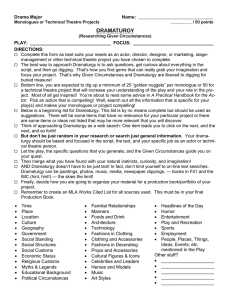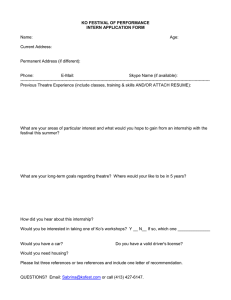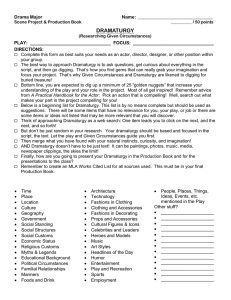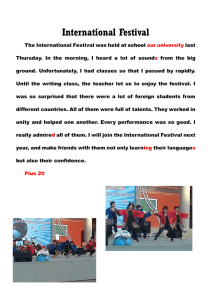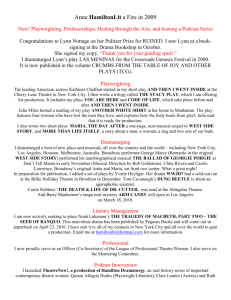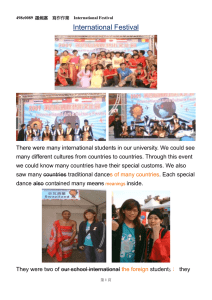Dramaturgy in Draupadi Festival: Community Performance Analysis
advertisement
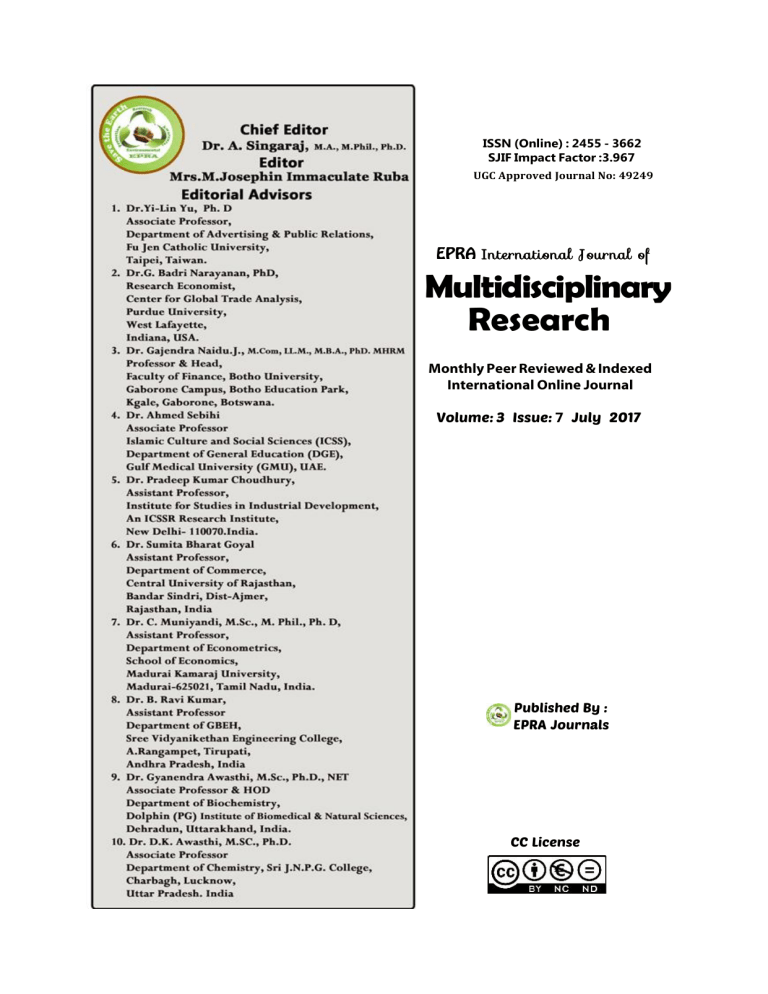
ISSN (Online) : 2455 - 3662 SJIF Impact Factor :3.967 UGC Approved Journal No: 49249 EPRA International Journal of Multidisciplinary Research Monthly Peer Reviewed & Indexed International Online Journal Volume: 3 Issue: 7 July 2017 Published By : EPRA Journals CC License SJIF Impact Factor: 3.967 UGC Approved Journal No: 49249 Volume: 3 | Issue: 7 | July 2017 EPRA International Journal of Multidisciplinary Research (IJMR) ISSN (Online): 2455-3662 COMMUNITY DRAMATURGY IN THE PERFORMANCE OF THE DRAUPADI FESTIVAL ABSTRACT The essay critically examines communityoriented dramaturgical practices in the context of the veedhi natakamu in Draupadi festival in Southern India, in the district of Chittoor in Andhra Pradesh. The essay argues that the Draupadi festival is not shaped by a single authorial or artistic perspective, but by the communities that are involved in it in elaborate ways: performers, spectators and festival trustees alike. The notion of dramaturgy is thus expanded in the process of adapting it to the ritual-performance contexts of the Draupadi festival, calling to attention the community aspects of creating and shaping events. Pejjai Nagaraju1 1PhD Research Scholar, Department of Theatre Arts, University of Hyderabad, Hyderabad, Telangana, India KEYWORDS: Dramaturgy, Draupadi festival, veedhi natakamu. 1. DRAMATURGY: TRANSLATING A WESTERN CONCEPT TO AN INDIAN CONTEXT process of production, and understanding of the verbal text (Greenwald, 2014, p. 177). The concept of dramaturgy proposed by Meyeroqitz in electronic media is stressed on the formation of social identity; Goffman interpreted dramaturgy as self-presentation; here, both Meyeroqitz and Goffman used dramaturgy in the field of social science (Michie, 2001, pp. 406-407). Except in social science, dramaturgy is significantly referred as „creating and organising a performance‟ in theatre, dance, circus, and opera. „Dramaturgy‟ originates from the Greek word dramaturgia which means „composing a play‟. In his publication Hamburgische Dramatugie, G.E. Lessing transported new dimension of „dramaturgy‟ as a practice for the theatre.i Goethe and Schiller were the first people who had created communication between dramaturg and director, and they introduced the acting applications, rehearsing the play, ensemble practice, analysing text, and directing in theatre practice (Turner & Behrndt, 2008, pp. 23-24). The term dramaturgy is observed in the fields of theatre, dance, circus, opera, and social sciences. Dramaturgy is a concept to bring logical and creative skills in theatre-making (Turner & Behrndt, 2008, p. 4). In dance, the dramaturgy was initially used in the process of choreography; later, the dramaturgy of dance is widely used in modern dance to understand the effect of body, scenery, location, and activities; choreographic dramaturgy is also observed as a field of practice-based research, and creative management (Hansen & Callison, 2015, pp. ix-xvii). When it is observed in the circus, the dramaturgy focuses in organising performers, studying risks, and analysing experiences of the audience (Leroux & R.Batson, 2016, p. 34). Opera is a branch of theatre dominating with stage actions, hence the dramaturgical process is called as operatic dramaturgy; operatic dramaturgy emphasises www.eprajournals.com 70 Volume: 3 | Issue: 7 | July 2017 EPRA International Journal of Multidisciplinary Research (IJMR) | ISSN (Online): 2455 -3662 | SJIF Impact Factor : 3.967 Dramaturgy is studying „internal structure of the production‟ (Turner & Behrndt, 2008, p. 17) to produce a dynamic performance. De Marinis (1987) describes the dramaturgy of the spectator as active, or passive; in the active part, spectators have a strong association with the performance space; in passive part, they are the object of the performance (p. 101). The offered evidence seem to suggest that dramaturgy in the theatre is a practice of collaborative production making within the aspects of text, space, performer and performance. The dramaturgy, then, in the present study, is taken as a process of creating, organising, and presenting a theatrical performance; and studying the spectators‟ responses. Ketaki Datta, in her paper „Dramaturgy in Indian theatre‟, has referred that dramaturgy „traces back to third century B.C.E.‟ in India‟; she has noted that the „Natyasastra: Treatise on Ancient community life. In such an analysis, the term dramaturgy, with its European legacies, might hopefully also be usefully expanded in certain ways, by moving away from a director or authorcentred idea of dramaturgy towards a communitydriven dramaturgy. In the following, I employ the notion of dramaturgy to broadly mean „collaboration‟ between folk performers and village communities. 1.1. Draupadi’s festival Across Southern India, thousands of shrines are dedicated to the mythic figure of Draupadi, worshipped as a goddess in many South Indian traditions. Worship in this context, however, means much more than prayer or an offering of devotional acts and objects. Rather, Draupadi shrines are often also sites of performance and community celebrations and gatherings. The villages conduct an annual Draupadi festival that lasts from 18 to 30 days during the summer, from March to August. The celebration of the festival used to happen after the harvest; even the harvesting time has changed in Andhra Pradesh, time for the celebration of the festival continues the same cycle of the time in Telugu calendar. In urban areas, the time of celebration is observed till October. This festival is a form of worship and celebration, which is rooted in history and culture of „Vannikula Kshatriyas‟ii in Chittoor district, Andhra Pradesh. Here, Vannikula Kshatriyas community shows significant role in organising ritual, narrative and theatre performances. The festival includes temple rituals, narrative performance, and theatrical performances. Narrative and theatrical performances are performed based on the Mahabharata text. People from 25 to 40 villages donate the festival. In these rural areas, five thousand villagers attend the festival. Village communities in Chittoor district believe that they must well organise the festival to acquire blessings from Pandavas. Thus, according to their belief system, conducting Draupadi festival for each year leads to get good rain, reap good crop, bring good fortune to villages, improve the wealth of animals and purify the sins of devotees. These belief system keeps the devotees to work together in performance making in Draupadi festival. In the Telugu speaking regions of Southern India, precisely in Chittoor, Nellore, and Kadapa districts, the Draupadi festival theatre is referred to as veedhi natakamu, literally street play. veedhi natakamu is not only a folk theatre form but also a musical play. veedhi natakamu performance is an amalgam of dance, songs, music, improvisations, and stylised acting. Depending on the budget and scale of the festival, veedhi natakamu performances can extend to a period of 10 to 18 days. The duration of each performance is eight to ten hours at nights. Indian Dramaturgy and Histrionics, Ascribed to Bharata Muni‟ is one of the best reliable text on Indian dramaturgy (Romanska, 2015, p. 94). Bharata presents his views on „success in dramatic production‟ in the twenty-seventh chapter of Natyasastra; according to him, ideal spectator must show peaceful mind, sense to detect faults, and minimum appreciation of theatre; ideal spectator, who responds to all emotions of a character, plays significant role in the success of production (Gosh, 1959, p. 519). In western theatre practice, this potential impact of spectators on the success of a production is perceived as the dramaturgy of the spectator (Barba, 2010, p. 183). In the context of modern Indian theatre practice, Indian dramaturgy is observed as integration and intersection of efforts of director, playwright and performer in making a performance; modern Indian dramaturgy, in playwriting, is also witnessed in adopting novels, myths, legends, tales, historical figures, and western classics; (Rubin, 1998, pp. 154-159). Karnad‟s Hayavadana is one of the examples for Indian dramaturgy because this play is adapted from a Sanskrit framed story, kathasaritsagara. The concept of dramaturgy is both inadequate and relevant in relation to community performance practices such as the Draupadi festival. On the one hand, it is inadequate as a term with specific European histories and legacies that cannot be simply transferred to Indian traditional performance contexts. On the other hand, it becomes interesting to analyse practices such as the Draupadi festival in dramaturgical terms in order to pay attention to aspects that are often times ignored in anthropological or sociological discussions, such as site-specificity, aesthetics, narrative structures, relations between different actors and roles. Also, it might serve as a way to understand the Draupadi festival outside of the frameworks of folklore or theology and view it in a more holistic manner, giving a place for imaginative and poetic aspects of www.eprajournals.com 71 Volume: 3 | Issue: 7 | July 2017 EPRA International Journal of Multidisciplinary Research (IJMR) | ISSN (Online): 2455 -3662 | SJIF Impact Factor : 3.967 Although veedhi natakamu is performed by professional actors, the participation of spectators and the involvement of persons appointed as the festival trustees are not insignificant. The dramaturgy of the Draupadi festival, therefore, needs to be examined from three inter-related positions, that of the trustees, the performers and the spectators. elected, local percussion players of dappuiii are directed to announce the festival to the public. After the ceremonial announcement, the trustees approach the public to collect donations. On the next auspicious day, they fix the budget, choose the performing troops, and meet the local decorators. Publicity for the festival includes distributing pamphlets and erecting printed flex boards. Before the festival begins, the trustees make sure that the temple premises and performance spaces are cleaned. Later, the performance space is decorated with locally available and symbolically charged materials, such as turmeric, vermilion, and leaves of coconut and mango. The space behind the acting areas is accommodated for performers to stay during the festival. This space also functions as backstage room for veedhi natakamu performance. The data gathered in 2013 suggests that the trustees of Vendugampalli temple spent 2,12,110 rupees to celebrate the festival; they paid 55,000 rupees to the veedhi natakamu troop for performing 10 days. 2. COMMUNITY DRAMATURGY IN THE PERFORMANCES OF DRAUPADI FESTIVAL 2.1. Dramaturgy of trustees Before the festival is initiated, officiants conduct a committee meeting with village heads to fix schedule. Then, they elect trustees to organise the festival. These trustees are men between thirty to fifty years old from Vannikula Kshatriyas community. If the temple is built by castes other than Vannikula Kshatriyas, then the trustees are elected from different castes in the village. The trustees are locally called as dharmakarthalu, i.e. managers of the festival. Once the trustees are Figure 1: A printed flex board to publicise the festival which was erected in Jeevakona, Tirupati. Sept 10, 2016. List of the performances, name of the theatrical troop and schedule of the performance at the centre; photos of trustees and an invitation note in local language at the bottom; at the top right, famous Harikatha performer V. Nagarathnam; and at the top, in bold letters, the name of the temple that host the festival. The stories, in the stage-based theatrical performances in the festival, are performed from the „Sri Krishna’s frolic‟ to „death of Duryodhana‟. These stories are very popular in entertaining the local spectators. In Draupadi festival, while the stage based performances are purely theatrical, outdoor performances are a combination of temple www.eprajournals.com ritual and folk theatre. These outdoor theatrical performances are slaying of Bakasura, uttara gograhanam, Arjuna‟s penance, Sacrifice of Ilavantha, and death of Duryodhana. In stage-based theatre performances, trustees keep a barricade in spectators‟ space to separate men and women. 72 Volume: 3 | Issue: 7 | July 2017 EPRA International Journal of Multidisciplinary Research (IJMR) | ISSN (Online): 2455 -3662 | SJIF Impact Factor : 3.967 Trustees arrange a light in spectators‟ space for stage-based performances. The average size of an open field in front of each Draupadi temple is between one and five hectares. This open field is dedicated to temple rituals and theatrical performance. At one corner of this open field, trustee uses a space to build a temporary or permanent stage for theatrical performances. Stage-based theatrical performances, in Draupadi festival, begins at 9 p.m. and ends at 6 a.m. the next morning. Before the actors begin the theatrical performance, one of introduces the play performance. the trustees Countable interruptions are observed during the theatrical performances. Trustees stop the performance any time to announce the next day event. Each day, they announce the names of donors of the events and festival. Approximately, they are visible on the stage thrice during the performance. Figure 2: A scene ‘The Disrobing of Draupadi’ performing on a permanent stage in Jeevakona, Tirupati. September 18, 2016. Trustees and spectators are watching performance standing at up left stage and sitting at upstage. Trustees advise actors to add or eliminate a scene. from traditional to more quotidian functions, such For instance, in a performance of Draupadi‟s as arranging the electrician and sound operators wedding which I attended as part of my field during the performances. As per my observation research in 2014, three scenes were eliminated in Yamaganipalli in 2014, the trustees cast the because of time limitations. In another example, the actors for specific roles. For instance, in the entry of a buffoon character was delayed until the performance of „death of Duryodhana‟, trustees maximum number of spectators arrived; in this tend to cast a popular actor for character situation, actors were advised to spontaneously add Duryodhana, in the hope of drawing large crowds. a scene or sing a devotional song to fill the gap. While stage-based theatrical performances Trustees‟ demands observed in changing the plot are purely performed for entertainment, the outdoor structure of the performance. For example, there theatrical performances are focused on devotion. was an observation that the trustees requested to These performances, with rituals, are performed to perform two parvas (episodes) in Mahabharata in fulfil the beliefs of devotees. As they are large scale one night; here, actors reduced the prose and enactments, outdoor theatrical performances are eliminated boring scenes. Thus, removing and enacted in paddy field or temple premises. adding scenes change the plot structure of the According to my field data, which was collected in performance in Draupadi festival theatre. Trustees‟ both Yamaganipalli and Vendugampalli villages in collaboration leads to these changes in plot 2014, performance of Arjuna‟s penance required structure of plays in Draupadi festival. one hectare of land and a wooden pole Sacred materials used in pre-performance approximately 20 to 30 feet tall; to perform uttara ritual are turmeric, vermilion camphor, husked gograhanam, performers used four hectare of paddy coconut, bananas, incense sticks, betel leaves, areca field; the performance space, in uttara gograhanam, nuts, and flowers. On the day of the theatrical was filled with nearly 50 to 100 cattle and 1000 to performance, trustees arrange the sacred material 1500 people; 15 square meters reclining statue was for pre-performance rituals. Their duty also extends prepared to perform death of Duryodhana; four www.eprajournals.com 73 Volume: 3 | Issue: 7 | July 2017 EPRA International Journal of Multidisciplinary Research (IJMR) | ISSN (Online): 2455 -3662 | SJIF Impact Factor : 3.967 hectares of land was occupied to perform death of Duryodhana; and sacrifice of Ilavantha was performed keeping ten feet sculpture of Ilavantha in the centre of one hectare; 10 to 30 number of trustee regulated approximately three thousand spectators in outdoor theatre performance; here, working together, trustees and village community organised these „large-scale performance venues‟. These evidences demonstrate the collaboration between trustees and village communities to organise such a „large-scale performance venues‟. Thus, in making Draupadi festival theatre, trustees collaborates in finance, advertisement, organising the space, conducting the rituals, providing safety measures, changing the plot, casting the performers, and organising the enactments. When it is observed the views on „production dramaturg‟ in modern theatre practice, the collaboration of trustees in making Draupadi festival theatre is very familiar to production dramaturgy in modern theatre practice. Mark Bly, in an interview with Bert Cardullo, views that production dramaturgs „compile for the director, designers, and actors basic background material‟ (Cardullo, 1995 , p. 108). As Mark Bly observes the role of production dramaturgs, one of the responsibilities of trustees in Draupadi festival theatre is to gather the necessities from performers and devotees to organise a performance. These necessities are included in operating the performance space, organising the actors, providing space for devotees to watch the performance, and arranging sacred material for each performance. Thus, trustees‟ role in making Draupadi festival is familiar to „production dramaturg‟ in modern theatre. 2.2. one village to another village. As the festival is celebrated once in a year in a temple, they are busy only for three months. Remaining nine months of these actors are dedicated to farming. Children are not included in these troops, but the woman is performed once in ten festival. The woman, who enters in a troop, is noticed as the wife of one of the performer. Performers‟ training includes noting dialogues, practising songs, copying movements. They imitate all characters taught by Guru. After his training, the actor performs a play in front of Guru. Later, the actor is recognised to perform a minor role for spectators. By his observations, the actor is taught to grasp other characters dialogues and movement. Each and every famous actor, after his long contribution to veedhi natakamu, becomes a Guru for young learners. When an actor becomes a Guru, he begins his veedhi natakamu troop. Here, Guru has his unique representation in providing dialogues. Songs and movement are same as he learnt from his Guru, but significant modification is noticed in passing the knowledge of dialogues and plot structure. Guru adds his imagination in teaching dialogues. This leads to change the dialogues, and plot structure from one Guru to other.Even though the performance text is based on Mahabharata, it is purely adopted by Guru and disciple. The adaptation of the text includes adding cinema songs, and contemporary social issues. As the text is orally transformed from Guru to disciple, performers have a major opportunity to improvise in these performances. Buffoon character is not associated with Mahabharata text; but, the character is designed to make jokes on duties, rights, and social practice. After delivering the prose by principal characters, the buffoon used to describe the meaning of the prose in the local dialect. This description helps illiterate village people relate to the classical text in classical Telugu. The performer who portrays a buffoon improvises massively in his part; because, the character buffoon always interacts with the spectators during the performance; buffoon is designed to entertain the spectators and comment of other characters. Not only buffoon character represents the quality of veedhi natakamu, but also it contributes in holding the spectators in these lengthy performances. Even though it is a comic character, buffoon demonstrates different views, such as philosopher, spectator, and critic on a scene. For instance, a buffoon in the play „The Disrobing of Draupadi‟ warns Dhushyasana not to disrespect women; he also suggests spectators to follow good deeds; he always has a dialogue with spectators to comment on a scene or a character. Dramaturgy of Performers A Guru who teaches veedhi natakamu must be good in playwriting, characterisation, dialogues, music, tunes, costumes, make-up, dramatic instincts, movement, and improvisations. Actors are trained under a Guru for at least six months to get on the stage. This intense training includes learning to know the text by heart, understand the plot, improvise the scenes, remember rhythmic movements, sing the songs and project the voice. The training for musicians extends to accompany the performance by providing mood, rhythm, and tempo. Harmonium, Tabla, Maddalam, cymbals are used to play music in these performances. Tunes of songs are from folk, classical, and popular Telugu cinema. „vaadhya prabandhas‟iv are used to accompany for rhythmic movement in veedhi natakamu. Performers in Draupadi festival are from local communities of Chittoor district. These performers, in most cases, travel as a group from www.eprajournals.com 74 Volume: 3 | Issue: 7 | July 2017 EPRA International Journal of Multidisciplinary Research (IJMR) | ISSN (Online): 2455 -3662 | SJIF Impact Factor : 3.967 Figure 3: A scene from ‘The Disrobing of Draupadi’ in Jeevakona, Tirupati. September 18, 2016. Here, Dhusyasana (extreme left) and Duryodhana (extreme right) and buffoon (in the centre, who is wearing South Indian Muslim dress) are performing a scene, where Duryodhana orders Dhusyasana to bring Draupadi. In this scene, buffoon, which is not related to Mahabharata text, warns Duryodhana not to disrespect a woman. Buffoon even passes his comments on adopting the classical text, and demonstrates in spectatorship. It is intended to appear in the performing buffoon. opening play, boring scenes and late at night. Thus, 2.3. Dramaturgy of Spectators using his improvisation skills, the actor portraying Draupadi‟s festival is a socially engaged buffoon collaborates to create a space for active art form. Different caste people participates in the spectators and unique performance in veedhi celebration of this festival. Spectators are from natakamu. In the case of enacting buffoon, actor‟s village communities who donate money for the collaboration, which leads to development in festival. Spectators have been watching veedhi performance in veedhi natakamu, totally depends natakamu since their childhood. Most of the aged on his improvisational skills. According to Barba, people know half of the veedhi natakamu text. actor‟s dramaturgy is defined as work of the actors They even recite their favourite part of the text in the progress of performance (Barba, 2010, p.23). along with the actors. There is always pressure Just like Barba‟s reflection on actor‟s dramaturgy, from spectators to add cinema songs and cinematic the actor who portrays buffoon uses his comedy scenes in veedhi natakamu performances; improvisational skills in the progress of veedhi this pressure leads to a change in the tempo of the natakamu performances. performances. Interludes for children offer Christoffersen (1993) says actor‟s entertainment that highlights the buffoon character dramaturgy is a way of the actor‟s expression in on stage. Scenes addressed to young adults tend to using text, subtext, quality of the voice, and emphasise sexually loaded jokes and innuendos. As physical movement (p.125). Actor‟s dramaturgy, as a result of these spectators‟ demands, stage-based Christoffersen refers, is similar to the efforts of the veedhi natakamu performances creates significant actors in veedhi natakamu; because, each actor uses space to entertain all kinds of spectators. the text, subtext, quality of the voice, and physical In earlier days, each caste was assigned to movement to show progress in each performance. do a particular job in Draupadi's festival. Still, this The dramaturgy of performer in Draupadi festival practice is noticed in these villages of Chittore theatre is planned to recognise the presence of the district. For example, schedule caste of the region performer‟s originality in performance making; it is publicises the festival with playing dappu. In also considered as performer‟s individual particular, caste of pambav collaborates in imaginative presence. As a result, it is verified that backstage work for the outdoor theatrical performer‟s dramaturgy origins in training, performances. This caste is allocated to prepare the entangles in improvisations, prolongs in adding reclining statue of Duryodhana for the play „death cinema songs, views in changing plot structure, www.eprajournals.com 75 Volume: 3 | Issue: 7 | July 2017 EPRA International Journal of Multidisciplinary Research (IJMR) | ISSN (Online): 2455 -3662 | SJIF Impact Factor : 3.967 of Duryodhana', and a standing statue of Ilavantha for „sacrifice of Ilavantha‟. Figure 4: A scene from ‘death of Duryodhana’ in Vendugampalli, Kuppam. June 3, 2014. Approximately 15 square meters reclining statue was prepared by village community for outdoor theatrical performance ‘death of Duryodhana’. Duryodhana, who is standing on the chest of the reclining statue, symbolically represents as he is hiding in the lake. And, Bhima is provoking Duryodhana to come out from the lake for the final fight. Stage-based veedhi natakamu performance begins at a warm night in the summer. Flood lights are lit to brighten the spectators‟ space at 6 p.m. One hour prior to the performance time, approximately 20 percent of spectators occupy spectators‟ space to have the best view of the performance. It appears that few of them bring snacks, and most of them carry their own mats to be seated. First, a prayer song is sung to offer Lord Ganesh. Next, as part of the pre-performance ritual, there are three more songs are sung to praise Lord Braham, Vishnu, Maheswara. Meanwhile, remaining spectators occupy the spectators‟ space. After these prayer songs, stage-based veedhi natakamu begins with a loud voice, stylised acting and rhythmic steps. During a performance, spectators invade into performance space to offer a currency as a gift to the actors. Some of the spectators sit on the stage to watch the performance. Along with actors, without any invitation, spectators participate in improvisations. For instance, in Vendugampalli village, 2014, in the play performance killing of Keechaka, I observed that a spectator invaded into the stage to enact as he punishes Keechaka. Spectators also interrupt the performance to request to repeat the favourite scenes. During veedhi natakamu performances, selected spectators are www.eprajournals.com invited to dance for at least two to four prerecorded cinema songs which are not related to Mahabharata text. These performers are amateur in dance, but enthusiastic to perform on the stage. All these interruptions bridge the gap between performers and spectators in veedhi natakamu. Each veedhi natakamu performance ends at morning. Half of the spectators‟ hurry to reach the home, but few of them participates in postperformance rituals. They sing a benedictory song along with performers. Some of the spectators help performers to replace the musical instruments. According to Eugenio Barba, spectators‟ dramaturgy is a process that operates the spectators‟ attention through the performer‟s actions (Barba, 2010, p.184). Similarly, as Barba refers spectators‟ dramaturgy, spectators‟ attention is operated in veedhi natakamu through the actors‟ actions, such as performing cinema songs, improvising buffoon character, balancing sexually loaded jokes, receiving currency from spectators during the performance, and requesting repeating the favourite scenes. Thus, spectators collaborate in improvising scenes, performing the dance for cinema songs, representing characters in outdoor theatrical performances, changing the plot structure, and helping the actors in backstage; all 76 Volume: 3 | Issue: 7 | July 2017 EPRA International Journal of Multidisciplinary Research (IJMR) | ISSN (Online): 2455 -3662 | SJIF Impact Factor : 3.967 these collaborations leads the spectators to be active participants in making of Draupadi festival performances; as a results of these collaborations, the role of dramaturg is witnessed. So, all these collaborations of spectators can be refed as spectator‟s dramaturgy. and nonspecific roles at different stages in performance making. Thus, this paper has offered views in dramaturgy process in the theatre. And, this study has also presented a critical analysis of dramaturgy process in Draupadi festival theatre in areas of performers, spectators and festival trustees. As an end of community collaborative approach to organising the festival, the role of dramaturgy in Draupadi festival performances was united by three areas: Dramaturgy of trustees, performers and spectators. In conclusion, it must be noted that Draupadi festival theatre has been drastically accepting perceptions of the local community. These enactments, to be sure, will always be a collaborative community theatre. 3. CONCLUSION: COLLABORATIVE DRAMATURGY AND COMMUNITY THEATRE As the managers of the festivals, trustees collaborated in organising performance spaces, managing finance, giving publicity, providing a safety measure for best performance, extending their suggestions in performance, arranging sacred material for pre-performance ritual, inviting dancers to perform for pre-recorded cinema songs, and adding and removing scenes. In order to learn the theatrical form, performers associated with his Guru to learn text, understand the plot, improvise the scenes, and remember rhythmic movements. This association with Guru pointed to form a unique performance in Draupadi festival theatre. The uniqueness of these performances also represented through improvisations, dances for pre-recorded cinema songs, changes in plot structure, and demonstration of a buffoon. As a result of these associations, performers dramaturgy originated in these performances. In Draupadi festival performances, the authority of dramaturgy was also in the hands of the spectators who are from village communities. Spectator‟s dramaturgy in these performances reflected not only within the process of performance making but also in the festival relationship to the village communities. As village communities organised these theatrical performances, they became an active part in these performances. These observations have proven the importance of trustees, performers and spectators in making of Draupadi festival theatre. Because the community associates in Draupadi festival theatre, the present dramaturgical process is called as dramaturgy of the community or community dramaturgy. In Draupadi festival, community dramaturgy reflected in the collaboration of village communities. Community dramaturgy was associated with involvements of these communities in different stages of performance making. Instead of following singular authority, village communities combined their belief and knowledge in organising the festival. They also negotiated with different kinds of people and their knowledge in celebrating the festival. Making Draupadi festival theatre established the process of dramaturgy as expandable enough to adapt to community performances. Here, the process the community followed was “collaboration” with both specific www.eprajournals.com Notes i For more details see Victor Lange‟s edition of Lessing‟s Dramaturgy, trans. Helen Zimmern (New York: Dover,1962) ii It is noted that “as relic of the origin of the Vannikula Kshatriyas from fire, the fire-pot, which comes in procession on a fixed day during the annual festivities of Draupadi and other goddesses, is borne on the head of a Vanniyar.”( Thurston, Vol 4, 1909, pp. 9-10 ) iii dappu is a percussion instrument, and it is used to announce any event to public in villages. iv vadya prabandhas are pure instrumental music with rhythmical composition (Samamoorthy, 1960, p. 58). v Pamba is a percussion instrument. The caste who play Pamba are called as Pamba cast, Pambavallu or Pambalollu in local language. In Andhra Pradesh, Pamba caste people play the musical instrument and sing songs to praise their folk deity. It is also observed in my field work that Pamba people make reclining Duryodhana statue for the performance of „Death of Duryodhana‟. REFERENCES 1. 2. 3. 4. 5. 6. 7. 77 Barba, E. (2010). On directing and dramaturgy: burning the house. London: Routledge. Cardullo, B. (1995 ). What is Dramaturgy? New York: Peter Lang Publishing. Christoffersen, E. E. (1993). The actors way. London: Routledge. Gosh, M. (1959). The Natyasastra: ascribed to Bharata-Muni. Calcutta: Asian Society of Bengal. Greenwald, H. M. (2014). The Oxford handbook of opera. New York: Oxford Univ. Press. Hansen, P., & Callison, D. (2015). Dance dramaturgy: modes of agency, awareness and engagement. Houndmills, Basingstoke Hampshire: Palgrave Macmillan. Leroux, L. P., & Batson, C. R. (2016). Cirque global: Quebec's expanding circus boundaries. Montreal: McGill-Queen's University Press. Volume: 3 | Issue: 7 | July 2017 EPRA International Journal of Multidisciplinary Research (IJMR) | ISSN (Online): 2455 -3662 | SJIF Impact Factor : 3.967 8. 9. 10. 11. 12. 13. 14. 15. 16. 17. Lessing, G. E., & Lange, V. (1962). Hamburg dramaturgy. New York: Dover Publications. Louis Patrick Leroux, . R. (2016). Dance dramaturgy: modes of agency, awareness and engagement. Houndmills, Basingstoke Hampshire,UK: Palgrave Macmillan. Luckhurst, M. (2006). Dramaturgy: a revolution in theatre. Cambridge: Cambridge Univ. Press. Marinis, M. D., & Dwyer, P. (1987). Dramaturgy of the Spectator. The Drama Review: TDR, 31(2), 100. doi:10.2307/1145819 Michie, J. (Ed.). (2001). Reader's Guide to the Social Sciences (Vol. 1). New York, USA: Routledge. Pil Hansen, D. C. (2015). Dance Dramaturgy Modes of Agency, Awareness and Engagement. Houndmills, Basingstoke Hampshire,UK: Palgrave Macmillan . Rubin, D. (1998). The World encyclopedia of contemporary theatre. London: Routledge. Sambamurthy, P. (1960). History of Indian Music. Chennai (Inde): Indian Music Publishing House. Thurston, E., & Rangachari, K. (1909). Castes and tribes of Southern India (Vol. 4). Madras, Tamilnadu: Government Press. doi:https://archive.org/details/castestribesofso04th uriala Turner, C. (2016). Dramaturgy and Performance. Basingstoke, Hampshire: Palgrave Macmillan. www.eprajournals.com 78 Volume: 3 | Issue: 7 | July 2017
